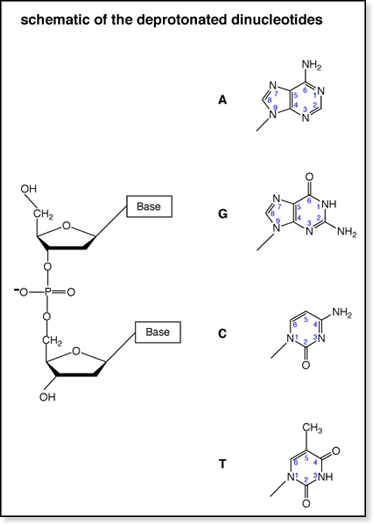|
Dinucleotides
- Introduction
 One
of the most important interactions that influence the structure of DNA
is that which occurs between the nucleobases. The bases are involved in
two primary types of interactions: hydrogen bonding and base stacking.
In duplexes, bases on one strand can hydrogen bond to a base on another
strand. The bases also stack on top of each other within their own strands. One
of the most important interactions that influence the structure of DNA
is that which occurs between the nucleobases. The bases are involved in
two primary types of interactions: hydrogen bonding and base stacking.
In duplexes, bases on one strand can hydrogen bond to a base on another
strand. The bases also stack on top of each other within their own strands.
In this section, the gas-phase conformations of
16 deprotonated dinucleotide ions are presented. The conformations were
determined by measuring collision cross sections of each ion using a MALDI-Sector
instrument and comparing them to cross sections obtained for theoretical
structures calculated by molecular mechanics. Shown
at right is a simple schematic of the deprotonated dinucleotides. Of particular
importance is the interaction between two bases on a single strand, without
the influence of base pairing from a second strand.
More detailed information can be found in:
"Gas-Phase
Conformational and Energetic Properties of Deprotonated Dinucleotides"
J. Gidden and M. T. Bowers Eur.
Phys. J. D 2002, 20, 409-419
"Gas-Phase
Conformations and Folding Energetics of Oligonucleotides: dTG-
and dGT-" Jennifer Gidden, John E. Bushnell, and Michael
T. Bowers J.
Am. Chem. Soc. 2001, 123, 5610-5611
|

